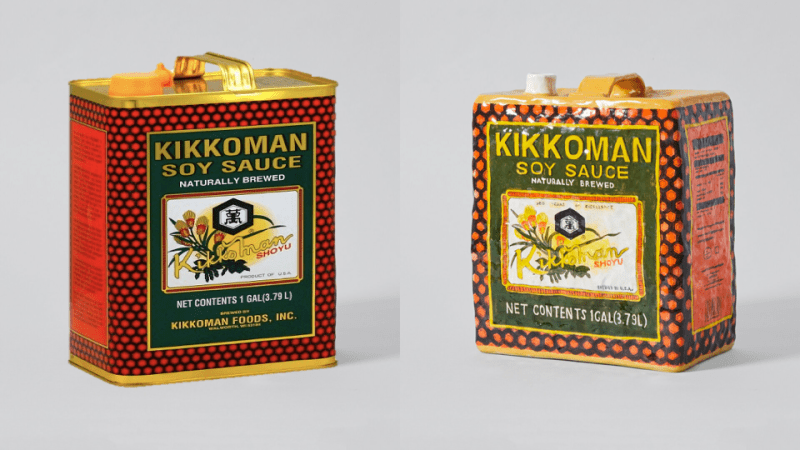Last week, Stephanie Shih’s account popped up on my Instagram. I scrolled through and immediately felt transported back to the suburban Maryland of my childhood, wandering the endless aisles of Asian grocery stores with my parents. Shih makes hyperrealistic sculptures of Asian foods: the Kikkoman Soy Sauce, the Chin Chin Grass Jelly, the Lao Gan Ma, the Chinkiang Vinegar bottle complete with the price sticker.
I’ve felt simultaneous unease and obsession over realistic sculptures of food — just because I can’t eat them. Maybe this duality reflects my Instagram feed, full of food blogger accounts with stretchy cheese and novelty-flavored ice cream. Food has increasingly become something that we see but don’t eat. Our wants stay unfulfilled. But Shih moves away from this by focusing on food’s connection with memory. “Diasporic nostalgia + the asian-american pantry,” her Instagram bio reads.
The level of detail, from the logos to the nutrition facts, make it clear that Shih is trying to make her products look as much like the originals as possible. But when I looked more closely at each piece, I saw the tiny bumps and inconsistencies in glaze. They’re wobbly like memory — something not quite exact, not quite food, something to keep for its nostalgia rather than to consume. Her work evokes a nostalgia that’s distinctly Asian American.
Popular Asian American YouTubers I watched religiously growing up, like KevJumba and Wong Fu, dedicated at least a few scenes to the Asian grocery store. Korean supermarket Lotte was the only space in my neighborhood that had free Mandarin newspapers and flyers for Chinese community events.
One summer, my parents dropped me off with a family friend every day while they worked. Instead of going to the park or the mall or the pool, we went to Lotte. I absolutely despaired over this, but all the while knew that I have never felt nervous or singled out or judged in Lotte, and neither have my parents.
At Stanford, I frequently went to 99 Ranch with Asian American friends just to poke at the red bean mochi. Despite growing up thousands of miles apart in different cultural contexts, the immediate connection we felt was comforting.
Shih has probably garnered the most attention for her dumplings. When I look at them, my brain immediately imagines a coat of flour over them. I need to remind myself that the dumplings’ soft creases are actually porcelain.
She’s made over 600 of them, which made me think, oh my god, 600? But Shih described the process as incredibly meditative, and as if working with actual dough.
“It was this muscle memory of folding them with all my āyís [aunties] around the table where everyone is teasing each other, like, ‘Yours are ugly. No yours are ugly,’” she told Edible Brooklyn.
I think about how I used to fold dumplings with my extended family, listening to gossip as I rolled the dough out way too thin. I remember making the dumplings more distinctly than eating them, as if the process was more significant than the product. When recreating factory-packaged foods, Shih’s work is delightfully imperfect and human-made. I think about the painstaking level of care required for her to paint each label on.
Unlike food, ceramic works never spoil or melt. It’s comforting to have something so concrete represent our blurry, shifting memories. It’s comforting that there are 600 ceramic dumplings as reminders of places like Lotte. Shih’s ceramics celebrate the Asian food that America has labeled gross and dirty and then suddenly capitalized on as a “trendy new cuisine.”
“I’m thinking about my younger self and what these images might mean to someone who feels that they have been deprived of having their own culture elevated,” Shih told NPR.
Contact Emily Zhang at ezhang3 ‘at’ stanford.edu.
